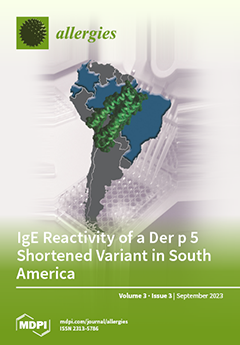Open AccessArticle
Removal of N-Terminal Peptide Impacts Structural Aspects of an IgE-Reactive Recombinant Der p 5
by
Camilo J. B. Vieira, Raphael C. Silva, Elisânia F. Silveira, Antônio M. S. Fernandes, Dumar A. Jaramillo-Hernández, Luis F. S. Garcés, Larissa M. S. Fonseca, Bruna A. S. Machado, Jamille S. Fernandes, Gabriela P. Pinheiro, Álvaro A. Cruz, Fatima Ferreira, Philip Cooper, Luis G. C. Pacheco, Neuza M. Alcantara-Neves, Carina S. Pinheiro and Eduardo S. da Silva
Cited by 1 | Viewed by 2451
Abstract
(1) Background: Modification of the structural elements of allergens is widely used in the field of allergies. The goal of the present research was to express, purify, and characterize the shortened recombinant group 5 allergen of
Dermatophagoides pteronyssinus (rDer p 5). (2) Methods:
[...] Read more.
(1) Background: Modification of the structural elements of allergens is widely used in the field of allergies. The goal of the present research was to express, purify, and characterize the shortened recombinant group 5 allergen of
Dermatophagoides pteronyssinus (rDer p 5). (2) Methods: rDer p 5 storage stability and aggregation capacity were explored through in silico analysis, dynamic light scattering (DLS), and SDS-PAGE. Serum IgE reactivity and cytokine amount were investigated in sera or cell culture supernatants through ELISA, MULTIPLEX
®, and Western blot analysis using sera from sensitized humans from Brazil, Colombia, and Ecuador. (3) Results: Dimeric rDer p 5 was detected through native PAGE, and this result was confirmed by data from DLS. The protein was thermically stable, as it did not degrade at 4 °C for 21 days. The shortened rDer p 5 was classified as a major IgE allergen in Brazil and Colombia, but minor in Ecuador. IL-13, IL-10, IL-1β, and IL-6 were significantly elevated in the sera of rDer p 5-reactive patients. The same cytokines plus IL-5 were more secreted by human cells upon rDer p 5 stimulation. (4) Conclusions: N-terminal peptide deletion led to a higher rDer p 5 folding stability, which, even though dimeric, was an IgE-reactive protein. Therefore, rDer p 5 could be used for molecular diagnostic applications or as backbone for hypoallergen design.
Full article
►▼
Show Figures



